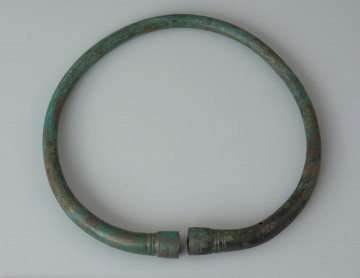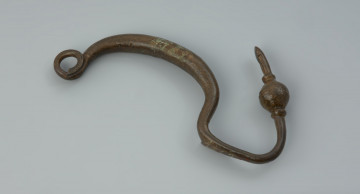
Copy of type I crown necklace (Kostrzewski)
National Museum in Szczecin
Part of the collection: Antiquity
A bronze neck-ring with short cylindrical ends and decoration on the outside has survived in two pieces. It represents one of several varieties of those neck accessories with various shapes of endings. From the 3rd century BC, the Germanic inhabitants of Western Pomerania had begun to use the ornaments, such as neck-rings and fibulae, to fasten clothes. Such decorative elements were characteristic at that time for the Celtic people living in southern Germany and Slovakia. This was a result of the phenomenon of the adoption of certain elements of La Tène culture by people of different origins. At that time, Western Pomerania was populated by the communities from Jastorf culture with completely different rituals and everyday objects than those of the La Tène culture. For example, in the cemeteries of the Jastorf culture, there are no male graves with weapons, which was typical for the Celtic people. Details of the discovery of the presented neck-ring have not been preserved in the archives. It is only known that it was accidentally discovered in 1922 in the gravel pit in Tarnówek, Goleniów poviat. It was an element of a stone-covered urned grave, which, based on its construction and furnishing, can be associated with the rituals of the Jastorf culture.
Bartłomiej Rogalski
Author / creator
Dimensions
cały obiekt: width: 0.8 cm
Technique
casting
Material
bronze
Creation / finding place
Owner
Muzeum Narodowe w Szczecinie
Identification number
Location / status

National Museum in Szczecin

BC 200 — 1
National Museum in Szczecin

National Museum in Szczecin
DISCOVER this TOPIC
Museum of King Jan III's Palace at Wilanów
DISCOVER this PATH
Educational path